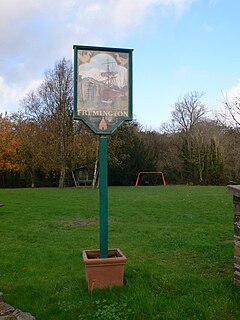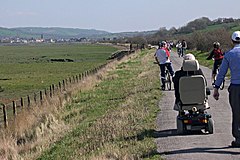Fremington, Devon
| Fremington | |
|---|---|
 Sign on the village green |
|
 The Tarka Trail is a direct part-coastal path following the former railway |
|
| Fremington shown within Devon | |
| Population | 4,310 2011 census |
| District | |
| Shire county | |
| Region | |
| Country | England |
| Sovereign state | United Kingdom |
| Post town | BARNSTAPLE |
| Postcode district | EX31 |
| Police | Devon and Cornwall |
| Fire | Devon and Somerset |
| Ambulance | South Western |
| EU Parliament | South West England |
Fremington is a very large village, civil parish and former manor in North Devon, the historic centre of which is situated three miles (5 km) west of Barnstaple. There is an electoral ward with the same name. The ward mainly covers the village and the population at the 2011 census was 4,310.Fremington is situated between the south bank of the tidal estuary of the River Taw and a small inlet of that river known as "Fremington Pill". Fremington Quay was formerly a port on the River Taw, half a mile north of the village centre. Fremington was formerly a borough which sent members to Parliament in the reign of King Edward III (1327–77). The parish includes the neighbouring former hamlets (greatly expanded in the 20th century) of Bickington to the east and Yelland to the west. Fremington hundred was one of the 32 historic hundreds of Devon. Fremington, Bickington and Yelland, all on the B3223 main road from Barnstaple to Instow have, according to Hoskins (1959), been spoilt by almost uninterrupted ribbon-building to provide housing for commuters to Barnstaple, but some old houses survive near the Church of St Peter, the parish church. and plenty of residential property on all sides of its roads between Bideford and Barnstaple. Little Bridge House in the village is a children's hospice run by Children's Hospice South West.
The parish church, dedicated to St Peter, was subject to thorough Victorian restoration in 1867 to the designs of the leading architect Sir George Gilbert Scott. The stone pulpit was buried during the Reformation and retains traces of the colour of the earth. St Peter's medieval tower unusually is positioned at the east end of the church, to the north of the chancel.
...
Wikipedia

